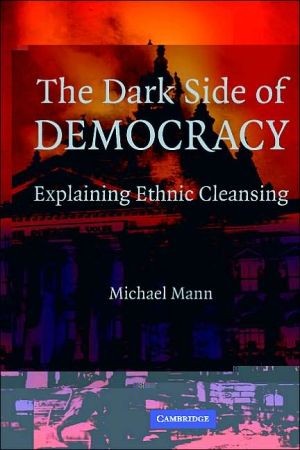

 |

|

The average rating for The Dark Side of Democracy: Explaining Ethnic Cleansing based on 2 reviews is 3.5 stars.
Review # 1 was written on 2011-02-16 00:00:00 Kathryn Hall Kathryn HallOkay so I only read the (rather loong) section on the Armenian genocide, but I found it very helpful. He has a Phase A -> Phase D schematic that allows a somewhat-neophyte to the whole affair to follow the progression of events to see how they degenerated into wholesale massacre. He does not justify it or show it as "inevitable" in any way, for those who might find that problematic, he just contextualizes the event and tries to pry apart the logic of both the Armenians and the ruling CUP party, soldiers, governors in the Ottoman Empire (and it was still the Ottoman Empire) in order to get inside the mechanics of how the atrocities happened on both sides. For an emotional subject like this I think a clinical approach is useful to all sides. Totally recommended to those interested in this particular genocide or the issue in general. |
Review # 2 was written on 2010-07-03 00:00:00 Thomas Williams Thomas WilliamsComes Up Short: Ethnic cleansing has been practiced by signers of the Atlantic Charter in the past and continues to be practiced by emerging democracies of today. A book addressing this issue is a welcome addition to the literature of the evolving history of human rights. Thus it is with great anticipation that I turned to the "Dark Side of Democracy". Unfortunately, the book falls awfully short of its promise. Its title is misleading and it contains a large number of misstatements of facts and factual errors and omissions. Neither the Armenian Genocide, atrocities of the Nazis and Communists nor Rawanda have anything to do with democracy as is implied by the book's title. Misstatements and distortions are too numerous to list, but here is a brief sampling: On p. 301 the reader is told that "In 1946 a Hungarian court in Cluj (now Kolosvar)..." The problems with the assertion are the following: (1) in 1946 the town you call Cluj was known to the overwhelming part of its population as Kolozsvar. In fact, the Romanian authorities renamed Kolozsvar (note the misspelling in the book) to Cluj-Napoca in 1974. (2) There did not exist a "Hungarian court" in Kolozsvar in 1946. On p. 305 in the section describing Romania the statement is made "Wild deportation began of the 200,000 Transylvanian Jews, more than 20,000 gypsies..." R. Braham, the internationally recognized expert in the field, in the introduction to "Tragedy of Romanian Jewry", Columbia University Press, 1994 writes "Jews of Old Romania and Southern Transylvania fared even better. Although they were subjected to great economic hardship, ...they survived the war almost intact." Descriptions of many events are incomplete. On p. 299 the reader is told about 3,300 civilians murdered in Voivodina by the Hungarian Army, but no mention is made of the terrorist activities preceeding these events. No mention is made of the fact that the Hungarian Army court martialed the officers responsible, the only instance where officers on the Axis side were held responsible for the killing of civilians, including Jews. The book fails to mention that alone of the allies of Nazi Germany, Hungary despite German occupation at the time, used its troops to protect Jews from deportation. Horthy ordered the Hungarian First Armored Division to Budapest preventing the deportation of Jews, about to be carried out from the Hungarian capital, in June 1944. It is remarkable that no mention is made of the murder of the estimated 30-40,000 Hungarian civilians by Tito's henchmen after the conclusion of the Second World War. Several books, some in English, exist on the subject. The book fails to mention the infamous, racist Benes Decrees that was the basis of depriving the autochthonous Hungarian population, living on land that was part of Hungary for a millenium but assigned to Czechoslovakia, of property, citizenship and deporting countless to slave labor. Ethnic Germans did not fare any better. The New York Times reported that the family of former secretary of state M. Albright profited from the seizure of German owned property. It is even stranger that the book makes scant mention of the estimated 2 million Germans who died as a result of ethnic cleansing of Germans from the East. The sentence on p. 355 "Germans flocked peacefully home" is offensive and mockery of the facts. For example, ethnic Germans of Romania, who were not murdered or deported to the Soviet Union, were allowed to leave only after the German government paid a ransom. These people left behind all their properties, owned by their families for centuries, with scant compensation. It is rather disturbing that the book on ethnic cleansing does not reference or mention two standards on the subject: "Ethnic Cleansing in Twentieth Century Europe", edited by S.B. Vardy and T.H Tooley, C.U. Press, 2003 and the A. M. de Zayas "Terrible Revenge", St. Martin's Press, 1994. Sixty years after these terrible events the reader has a right to be told all that is known about these events and not an excerpt of some of the facts. That this is possible is shown by J. Faragher "A Great and Noble Scheme", Norton, 2005 retelling the expulsion of French Acadians from their homeland. The "Dark Side of Democracy" falls far short of these expectations. |
CAN'T FIND WHAT YOU'RE LOOKING FOR? CLICK HERE!!!